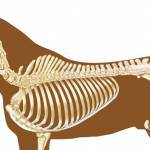Early Veterinary History: From Caves to Classrooms

Almost as soon as humans began the management of wild cattle, sheep, goats, and other animals as a food source, the role of shaman or healer of human ills was expanded to include treatment of diseases and injuries in livestock. Though there are no veterinary records from this era, these earliest veterinarians likely used similar magical chants and herbal libations to cure both man and beast. Some of the very earliest written records of veterinary treatment date to around 1900 B.C. in Egypt.
Knowledge gained from these and other early animal healers was gathered into the first known veterinary manual, the Hippiatrika.Other early records are from the time of Hippocrates, a Greek physician and accomplished horse doctor. Known as the “Father of Medicine,” Hippocrates shared his knowledge and methods with other early practitioners in the period around 400 B.C. Fifty years later, Aristotle dispensed more knowledge gained as he dissected and studied at least 50 types of animals.
Claudius Galen, another Greek physician living from 131 to 201 A.D., served as the doctor and surgeon for a school of gladiators. Galen also dissected animals and studied their anatomy. Though his understanding was impressive for his time, he believed that the health of humans and animals was closely related to phases of the moon and astrological signs, and his treatments were based on these principles.
Knowledge gained from these and other early animal healers was gathered into the first known veterinary manual, the Hippiatrika. This hand-written volume was carried along as Roman armies traveled with their horses into Asia Minor in the third and fourth centuries A.D. Advances in animal care continued to be written down by Apsyrtus, a fourth-century veterinarian who wrote descriptions of the diagnosis and treatment of infectious and contagious equine diseases, and Laurentius Rusius, whose book contained detailed instruction on riding as well as on treating sick or injured horses. Flavius Vegetius contributed a comprehensive volume on the care of mules in about 430 A.D. His was one of the first books to espouse the idea that illness was caused by natural factors, not by evil spirits or other superstitious explanations.
Little progress in human or veterinary medicine was made in Europe during the Dark Ages, but among the keepers of Arabian horses in northern Africa, this was a time of significant learning in the areas of horse care and breeding. This knowledge made its way into Europe after about 1000 A.D., where most of the treatment of sick or injured horses fell to farriers.
Leonardo da Vinci (1452-1519) was neither a physician nor a veterinarian, but his detailed drawings of dissected animal and human bodies added greatly to the understanding of anatomy.
With the invention of the printing press in 1450, it became easier to reproduce written material, and knowledge of all types was more widely disseminated. Libro de Albeyteria, a veterinary manual, was printed in 1547, helping to provide written information to practitioners. When Claude Bourgelet founded the first school of veterinary medicine in France in 1761, students were required to memorize the entire text of the current veterinary manual. As well as veterinary techniques, the students were also schooled in horsemanship and farriery. The success of this first veterinary college was rapidly followed by more than a dozen such schools in Italy, Germany, Spain, and England. Eventually, North American veterinary colleges were founded in Mexico in 1853, in Canada in 1862, and finally at Cornell University in New York in 1868.








